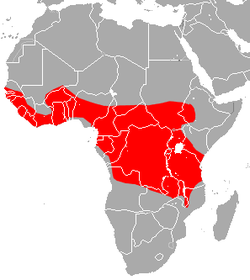Biology
Some populations of the bat are partially diurnal, with daytime foraging, chases, and other activity observed in populations of H. ruber on the island of São Tomé. [3]
Diet
The bat seems to hunt by detecting the fluttering of wings by moths to decide whether to attack. If a moth was not fluttering its wings, or stopped during an attack, the bat would terminate its approach. The bat also does not use sight or sound to detect fluttering of wings. This appears to be a way to reduce clutter while hunting. [4]
Echolocation
The bat echolocates at a frequency of 132-138 kHz. [5] [6]
Habitat and distribution
The bat's range extends throughout much of West, Central, and East Africa and part of southern Africa including Angola, southern Democratic Republic of the Congo, northern and eastern Zambia, southern Malawi and north-western Mozambique. The bat can be found up until 2300 meters above sea level.
The bat mainly inhabits lowland tropical moist forest but is also found in relic and riverine forests in dry savanna. The bat is known to roost in caves, rocky crevices and abandoned mineshafts. Animals have also been found under a bridge, in a hollow kapok tree and in derelict buildings. [1]
This page is based on this
Wikipedia article Text is available under the
CC BY-SA 4.0 license; additional terms may apply.
Images, videos and audio are available under their respective licenses.


